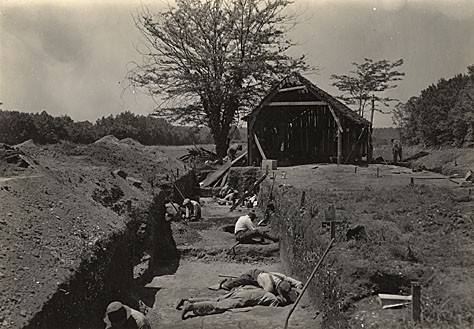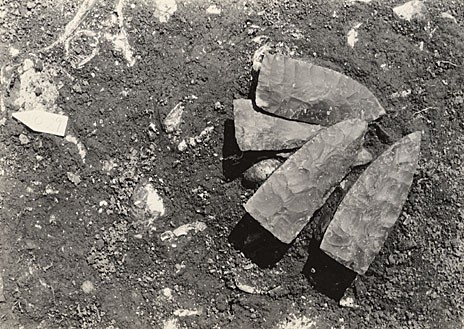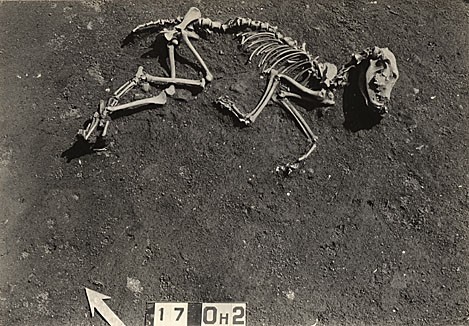Indian Knoll
Introduction
Text-to-speech Audio
Images
Men working at Indian Knoll under the Works Progress Administration.

Cache of chipped stone knives from Indian Knoll. Photograph courtesty of William S. Webb Museum of Anthropology.

Canine Burial at Indian Knoll.

Backstory and Context
Text-to-speech Audio
The original excavation in 1915 was led by C.B. Moore and his crew of eight men. He was the first to report on the bannerstone at Indian Knoll and recover 298 individuals, 66 of which were well preserved and sent to the United States National Museum. After the flood in 1937, Webb and his team began a second excavation, leading to the discovery of 880 more burials. The Indian Knoll skeletal population was inadequately evaluated by Moore, so in 1960, the remains were reassessed by Francis Johnston and Charles Snow. From the skeletal fragments, they estimated there to be at least 1,234 individuals, rather than 1,178 reported between Moore and Webb.
Johnston and Snow concluded that Indian Knoll had a high infant mortality rate, mostly only under one year, but also many under four. The average life span was about 18.5 years old, with slightly more male burials than female. The 1939 excavations included trenches paralleling the Green River which contained over 1000 burials, and evidence of ancient dwellings with clay flooring, six hearths, and what Webb noted as kitchen fireside tools, or artifacts such as hammerstones grooved axes, pitted stones, mortars and pestles. There were also some 67,000 artifacts uncovered at Indian Knoll, some of which were carbon dated, and thought to be an average of about 5,300 years old. These dwellings are considered to be permanent occupations.
Most of the skeletons were found in tight coiled positions, which indicates the bodies may have been wrapped, though there are a few instances of being placed sitting up, with even less fully extended. The large number of burials caused graves to intrude into others accidentally, though multiple burials were common practiceduring the time the shell midden formed between the years 5500 and 2000 BC.Multiple burials were also typically circular, but larger and lacked grave goodsexcept for single projectile points near the chest cavities, which suggest violence near time of death. Many skeletons were found dismembered, either unintentionally or as an act of mutilation. If a grave happened to be dug intruding another, the original body may have become dismembered, but normally the bones would have been piled up and reburied. Occasionally pieces, such as skulls or limbs, were not recovered, which Robert Mensforth considered evidence for warfare and trophy taking.
Grave goods were found within 187 burials, though shell beads, used for personal adornments or sewed on garments, were not counted as a deliberate grave goods in one study. The artifacts commonly associated with graves include pestles, hammerstones, grooved axes, projectile points with a few cases of copper and stone vessels. There were atlatl 43weights, also known as bannerstones for spear throwers associated with burials at Indian Knoll, and Webb’s research focus when excavating this site to get more information on this particular grave good.his site was never fully excavated because of what Webb called, difficulties arising from a shortage in the Works Progress Administration labor quota of the county, but little area was left unexplored. In 1966 Indian Knoll was designated a National Historic Landmark and today the site lies within 290 acres of private agricultural fields.
